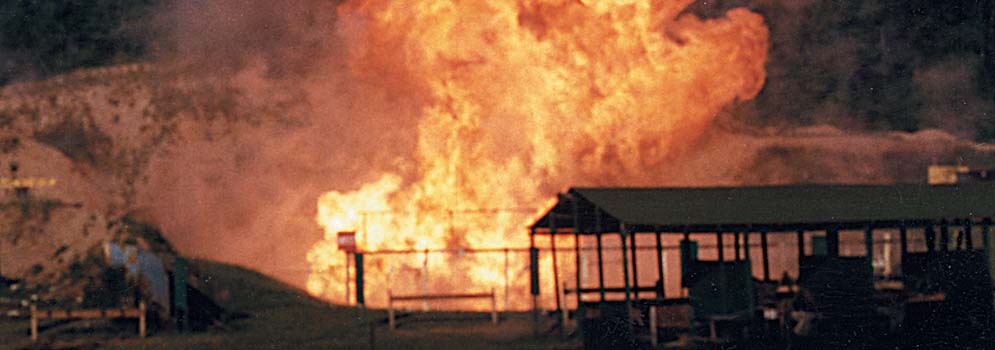By Lee H. Arten
The Second Chance Combat Shoot, held outside the small Michigan town of Central Lake each year, is the premier bowling pin match in the world. It is famous for the number of bowling pins smacked, splintered and shattered with .45 autos, magnum revolvers, and 12 gauge shotguns loaded with double and triple ought buck. Second Chance, which begins the second Friday in June each year and runs for eight days, is also one of the centers of full auto shooting in the Midwest . Central Lake is about 40 miles northeast of Traverse City, in some of the prettiest country in the state.
According to Richard Davis, developer of Second Chance body armor, head of the Second Chance Body Armor Company and Numero Uno of the Second Chance Shoot, all the full auto events at the shoot came out of a joke he stole from Mel Brooks.
In The History Of The World, Part I, Mel Brooks looks around and says, “We Romans have a god for everything except premature ejaculation—and that’s coming quickly.” Richard looked around at the 1984 shoot and amended the joke to fit Second Chance and sub guns. In 1985 the Premature Ejaculation Event (PEE) was held for the first time. In 1997 there were four main submachine gun events, and the Spray and Pray event on the practice range.
The most venerable of the full-auto events is the PEE. It has changed over the years, but it always includes multiple targets, gun movement, and a target that must be shot last. The course isn’t difficult to understand, or shoot. (For the last few years it has also been shot with semi-auto handguns.) What is difficult is shooting it fast enough to do well. Winning times, with either handgun or subgun, hover around three seconds. The PEE subgun record is held by Tim Crosno with a 2.85 time. The handgun PEE record, also set in 1994, is held by Pat Sweeney. He shot the course in 2.94 seconds.
When I first shot the PEE, in 1989, there were falling plates, bowling pins and a pop up target of a felon with a shotgun for a stop. I used a Mac 10, a Thompson and an M3. I was most comfortable with the M3. With the combined slow rates of fire, however, I never got to the pop-up target in time.
One year Richard decreed that everyone would use .45 Reising subguns, and that the amount of ammo left in the gun after all the targets were down would be deducted from the time according to a complicated formula that I’ve forgotten. I tend to shoot in short bursts, so I did my best that year.
The biggest recent change has been the disappearance of the bowling pin from the PEE. For the last few years everyone has fired at eight self-sealing plastic plates. There are seven white targets and a red stop plate. Most shooters start on the left and take four or five targets down. They then swing to the last target on the right, take it and the target next to it, and then swing back to the center for either the middle target and the stop plate, or the stopper alone, if it is all they have left.
I’ve seen the PEE event won with a Thompson. The man who won had his own. He shot the course as many times as he was allowed, and had his wife sit on the grass behind him loading magazines. The gun of choice now is usually an MP5. The cyclic rate is high, the recoil is minimal, and the sights are good. I prefer one with a fixed stock. The folding stocks seem too short, and MP5s with them don’t get on target as fast for me. Other shooters, including some who have placed in the PEE, have also said that they prefer the standard stock.
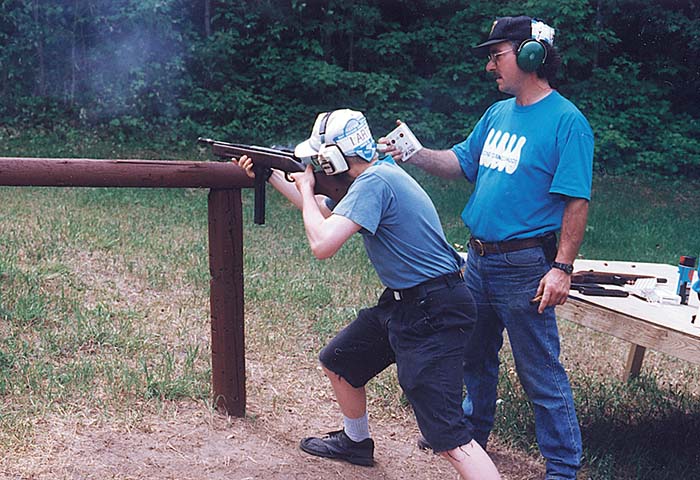
Next to the PEE is The Ball Buster. This event debuted in 1996. According to Davis, it depends almost totally on luck. The shooters mount a 10 foot tower, (Davis sometimes calls it “The Tower Of Murder” with appropriate movie announcer voice effects) and grasp a fully loaded MP5. Then they hose the 30 rounds in the magazine into a tank of water in one burst. The tank is a four foot cube and does a good job of soaking up the bullets. The object, besides making noise and throwing water all over, is to blow out of the tank, or sink, all 30 ping pong balls floating in a small plastic ring in the middle of the tank.
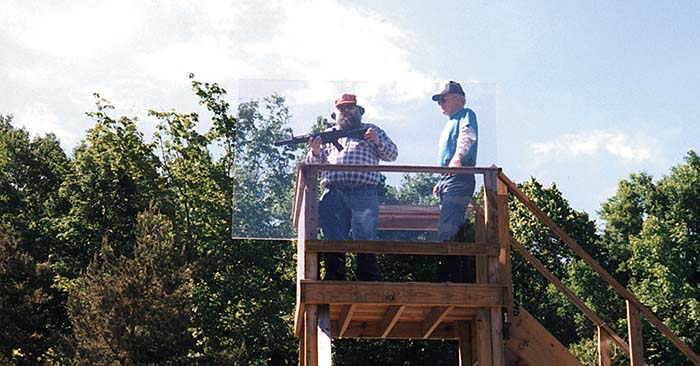
Jerry Miculek usually finishes high in the Ball Buster standings. The famous professional shooter, formerly of Team Smith & Wesson, now shooting for Clark, told me he had figured out a plan for shooting the event. He didn’t tell me exactly what it was. The only plan I’ve been able to come up with is to make sure I don’t let up on the trigger until the gun is dry. The event seems to take no time at all, and too long at the same time. After the first shot or two hits, there is so much water flying that locating targets is difficult. I’ve always thought I was doing fairly well, because there were very few balls left in the ring. Unfortunately most of the balls are still floating inside the tank when I come down off the tower. I often wonder if I aimed right in the corner of the ring at first, alot of the little suckers would jump out onto the grass.
Second Chance competitors get several letters from Richard Davis during the year. These often contain information about new events scheduled for the next Second Chance Shoot. I don’t remember any notice of the newest full auto event before Second Chance ’97. As soon as the full auto range opened up, I heard something different going on. I found it was an event called Raptor Road. Shooters used Reising submachine guns owned by Davis to shoot down ten steel “popper” type targets. The targets had been painted with stylistic predatory winged creatures. The paintings didn’t last long. Along with much of the black base paint, they were blown away by blast after blast of Cor-Bon .45 hardball.
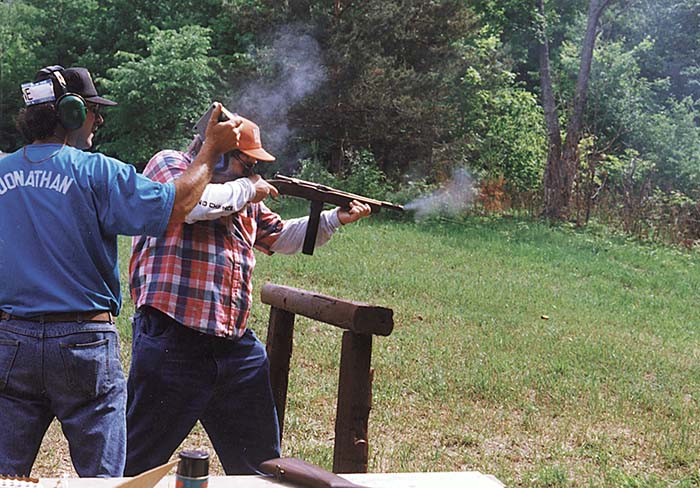
Raptor Road was supposed to be shot in one burst and to get a score, all the steel targets had to be knocked down. The Reisings could be emptied in about 2.5 seconds, so shooters with quick reactions would have an edge. There were two or three Reisings available but shooters couldn’t hold out for one with a faster than average cyclic rate. Instead, they had to rotate from one gun to the next. This was done to minimize damage to the Reisings from overuse.
The event started with the Reising touching a waist-high rail. It wasn’t long before competitors decided short loading the magazine would help make good times. Crouching behind the rail so the Reising only had to be moved a short distance to the targets was also a technique adopted by many shooters. Competitors I spoke with were loading as few as 22 rounds into the 30 round magazines to try and cut their times. Of course, even from a crouch the targets had to be hit to count. I saw several shooters who had the form down, but neglected to hit all the targets. I stood up and shot off my hind legs. Running the Raptor five times, the best I did was to leave two targets standing.
I talked to Richard Davis late in the match. He said that Raptor Road was going to be a fixture of Second Chance, but that there would be changes. One thing he said he might do was add targets, and subtract rounds. Since it would be almost impossible to get all the targets, the score would be the number of targets a shooter knocked down. The event would continue to be fired in one burst.
An eagerly anticipated part of Second Chance is the Wednesday night Propane Blast. Davis gets a lot of leaking propane cylinders, stands them shoulder to shoulder on the back range, and lights them up with incendiary ammunition. Davis usually starts the party with his suppressed .50 BMG rifle, made from a World War I German anti-tank rifle. Now and then he uses his M2. For the last few years machine guns of various types have been set up on the back range to add a little more blast. A lot of these guns are loaded with tracers, so while the propane tanks are cooking green and red tracers streak into the smoke and flame.
Second Chance Body Armor and shoot head Richard Davis is a machine gun dealer, along with his other activities. The shoot attracts other dealers each year, too. For as long as I’ve been competing machine guns have been available to shoot on a pay-as-you-blast basis. I often make the mistake of waiting until I’ve spent a lot of money on side events, custom gun work, and memorabilia before trying to decide what I can afford to shoot. Assault rifles, machine guns, and other weapons I have managed to scrape up the cash to fire include the M16, the FN D, and a full-auto Ruger 1022.
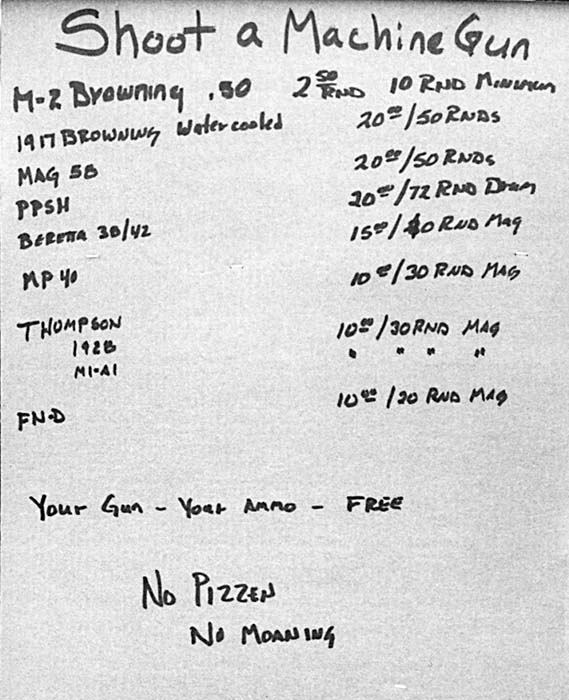
There are usually non-commercial full-auto and other exotic weapons on the line too. In 1997 one man was having a lot of fun with a Bren. In other years I’ve seen watercooled Browning machine guns, a Colt Potato Digger, several BM59s, and a 9mm Gatling. The ground where the shooter with the Gatling sat was nearly ankle deep in fired brass.
I’ve gotten on talk radio, gone to town meetings to speak to politicians, and done writing workshops for pay, but one of the best bits of talking I ever did was the time a few years ago when I convinced a shooter on the back range at Second Chance to let me fire his Mauser Schnellfeuer. Experience with a semiautomatic Broomhandle had left me rather suspicious of the breed. The Schnellfeuer, with its 20 round detachable magazine, was easier to manage in loading, and, once I got the working of the selector button explained, a lot of fun in full auto. The shoulder stock was too short, of course. I had to crane my neck and move my head back and forth to find the sights. Once that was taken care of the Schnellfeuer was rather impressive. I even noticed a certain amount of recoil while firing three and four round bursts of .30 Mauser. I haven’t seen that guy at Second Chance again, but I keep my eye open for him each year.
The Second Chance Combat Shoot is known as handgun event, even though people attend each year with the basic intent on competing with shotguns or rifles. It is also one of the few places in Michigan where shooters can compete in full auto courses, and see and shoot many different machine guns. I haven’t missed Second Chance for the past nine years. I would go if it was limited to handguns, but the full auto events are also a big reason I attend.

The Second Chance Shoot, Inc., can be contacted at P.O. Box 579, Central Lake, MI 49622. Or call 1-800-253-7090 for information and entry forms.
| This article first appeared in Small Arms Review V1N8 (May 1998) |



